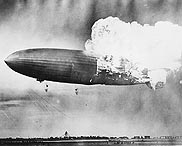
Jolson Didn’t Appear in His Own Movie
Actor Al Jolson (pictured) had Larry Parks take his place in “The Jolson Story,” a 1940s movie, tracing Jolson’s rise to stardom. But Jolson, still alive and well, dubbed his own songs.

Nuclear Disarmament
The peace symbol, created by Gerald Holtom in 1958, incorporates the semaphore letters N and D inside a circle and was meant to stand for Nuclear Disarmament. Some of the first peace symbols appeared on fired pottery badges, designed to survive the inferno of a detonated nuclear bomb.

Cooking Not Her First Career
Born in 1912, Julia Child was already 50 years old when she started cooking on television — an unexpected career. Child left college in 1934 with plans to become a novelist, and her first job was as a writer of advertising copy. But life doesn’t always turn out as expected.

Smiling Water Towers
From Selma, Ala., to Oconto Falls, Wis., at least 21 U.S. cities have water towers with painted-on smiley faces. But Calumet City, Ill., with two such towers, claims it was the first. It all started with 8-year-old resident Kim Fornero, who sent a letter to the city council in 1972, claiming that a smile would be more fun to look at than a plain, old water tower. Fornero’s simple suggestion proved catchy indeed.

Fat Neckties
Fashion authorities agree that the standard width for a necktie is 3-1/4 inches, with a length of 52 to 58 inches. But that hasn’t always been the case. In the 1970s, men’s ties grew fatter — up to 5 inches across — in order to fit that decade’s wider suit lapels and longer shirt collars. Groovy.

The End of an Era
When the Hindenburg (pictured) went down in flames on May 6, 1937, the accident marked the end of an era for airships, searing the public consciousness and raising well-founded safety concerns. But the Hindenburg was far from the largest dirigible-related disaster. More than two-thirds of its 97 passengers and crew survived. Not so for the U.S. Akron. That American craft crashed into the Atlantic Ocean on April 4, 1933, killing 73 of the 76 aboard.

A True Survivor
Charles de Gaulle (pictured), president of France from 1958 to 1969, survived more than 30 assassination attempts from 1944 to 1966. In one instance, de Gaulle’s Citroen was showered with bullets, but witnesses claim that neither de Gaulle nor his wife tried to protect themselves. De Gaulle, on exiting the vehicle, referred to the assassin as a bad shot. His wife said there was no reason to be frightened as she and her husband would have welcomed a chance to die together and avoid the pains of old age.

Killer Tennis Balls
Historians agree that if not for tennis balls, Scotland’s King James I might have lived a long life. Instead, he was assassinated. The problem? On the night of his death, Feb. 20, 1437, the King of Scots tried to escape down a sewer drain, forgetting that he had commanded it sealed to prevent his tennis balls from rolling into it. He was quickly discovered and killed.